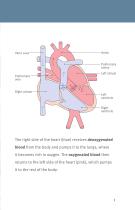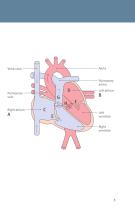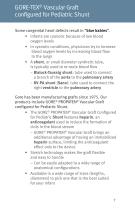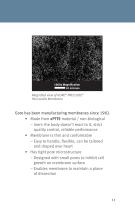 Website:
Gore
Website:
Gore
Catalog excerpts

Parents’ guide to pediatric congenital heart defects Cardiac surgical solutions
Open the catalog to page 1
Patient information: My child’s first name:
Open the catalog to page 2
Congenital heart defects 4 - 5 History of W. L. Gore & Associates 20 - 21 Notes and heart diagram 22 - 24
Open the catalog to page 3
Vena cava Aorta Pulmonary artery Pulmonary vein Right atrium Left atrium Left ventricle Right ventricle The right side of the heart (blue) receives deoxygenated blood from the body and pumps it to the lungs, where it becomes rich in oxygen. The oxygenated blood then returns to the left side of the heart (pink), which pumps it to the rest of the body.
Open the catalog to page 5
The heart: • Is an organ - Made of muscle - Approximately the size of your fist - Located within the chest • Pumps blood - Needed to deliver oxygen and nutrients to the body • Contains two pumps — one on right side, one on left side - Right side pumps blood to the lungs, where it becomes enriched with oxygen (A) - Left side pumps oxygen-rich blood to the rest of the body (B) Blood flow through the heart: • Veins are blood vessels that return blood to the heart • Veins empty blood into atria (plural of atrium), the upper chambers of heart - Right atrium (C) and left atrium (D) • Blood is...
Open the catalog to page 6
Vena cava Pulmonary artery Pulmonary vein Right atrium Left atrium Left ventricle Right ventricle
Open the catalog to page 7
Congenital heart defects Heart defects are the most common type of birth defect. • Nearly one out of 125 babies is born with a heart defect in the U.S.1,2 Congenital heart defects are structural abnormalities of the heart that are present at birth. • Can involve the heart walls, valves, and /or great vessels • Parts may be incomplete, missing, or formed incorrectly; may include holes between heart chambers; valves can be leaky or narrow; or vessels may be narrow • Most common types of congenital heart defects are3: – Ventricular septal defect (20%) – Atrial septal defect (10%) – Patent...
Open the catalog to page 8
1. Birth defects. Congenital heart defects. March of Dimes. http://www.marchofdimes.com/baby/birthdefects_congenitalheart.html . Published May 2008. Accessed December 21, 2011. 2. Congenital heart defects. What are congenital heart defects? U.S. Department of Health and Human Services. National Heart Lung and Blood Institute. http://www.nhlbi.nih.gov/health/health-topics/topics/chd/. Published July 01, 2011. Accessed December 21, 2011. 3. Jacobs JP. Nomenclature and classification for congenital cardiac surgery. In: Mavroudis C, Backer CL, eds. Pediatric Cardiac Surgery. 3rd ed....
Open the catalog to page 9
Gore has been making high-quality, reliable medical products for the surgical treatment and correction of congenital heart defects for more than 40 years. Our cardiac surgical products include: • Pediatric shunts • Cardiovascular patches • Pericardial membranes • Vascular grafts
Open the catalog to page 11
GORE® PROPATEN® Vascular Graft configured for Pediatric Shunt Depiction of a Blalock-Taussig shunt, a procedure that is commonly used to treat “blue babies” by increasing blood flow to the lungs. Consult with your physician for complete information
Open the catalog to page 12
Some congenital heart defects result in “blue babies”. • Infants are cyanotic because of low blood oxygen levels • In cyanotic conditions, physicians try to increase blood oxygen levels by increasing blood flow to the lungs • A shunt, or small diameter synthetic tube, is typically used to re-route blood flow - Blalock-Taussig shunt: tube used to connect a branch of the aorta to the pulmonary artery - RV-PA shunt (Sano): tube used to connect the right ventricle to the pulmonary artery Gore has been manufacturing grafts since 1975. Our products include GORE® PROPATEN® Vascular Graft...
Open the catalog to page 13
GORE® ACUSEAL Cardiovascular Patch Pulmonary artery widened with an ePTFE patch Ventricular Septal Defect repaired with an ePTFE patch Cardiovascular patches are used to widen the pulmonary artery and to repair a hole in the wall between the left and right ventricle, known as a Ventricular Septal Defect (VSD). They are also used to repair or reconstruct cardiac and vascular structures. • Repairing holes in the walls of the heart (Atrial Septal Defect, Ventricular Septal Defect) • Reconstructing a malformed vessel (Aortic Coarctation) Consult with your physician for complete information.
Open the catalog to page 14
GORE-TEX® Cardiovascular Patch Gore has been manufacturing cardiovascular patches since 1981. Our products include GORE-TEX® Cardiovascular Patch and GORE® ACUSEAL Cardiovascular Patch. • GORE® ACUSEAL Cardiovascular Patch contains inner fluoroelastomeric layer – mproves patch’s ability to “seal” I around sutures, offering an advantage for vascular procedures • Made from ePTFE material / non-biological – Inert: the body doesn’t react to it, strict quality control, reliable performance • Conformable – asy to handle, flexible, can be cut-to-size E for specific application • Available in a...
Open the catalog to page 15
GORE® PRECLUDE® Pericardial Membrane Pericardial fluid GORE® PRECLUDE® Pericardial Membrane is used to repair or reconstruct the pericardium. • Pericardium is a fluid-filled sac surrounding the heart • During open heart surgery, the surgeon must cut into the pericardium to access the heart • Without an intact pericardium, there is an increased risk of adhesions forming between the heart and chest wall after surgery – Makes re-operation difficult – Obscures cardiac structures • GORE® PRECLUDE® Pericardial Membrane covers the heart and makes re-operation easier, if necessary Consult with your...
Open the catalog to page 16
Magnified view of GORE® PRECLUDE® Pericardial Membrane Gore has been manufacturing membranes since 1982. • Made from ePTFE material / non-biological – Inert: the body doesn’t react to it, strict quality control, reliable performance • Membrane is thin and conformable – asy to handle, flexible, can be tailored E and draped over heart • Has tight pore microstructure – esigned with small pores to inhibit cell D growth on membrane surface – nables membrane to maintain a plane E of
Open the catalog to page 17All Gore catalogs and technical brochures
-
Decades of data
2 Pages
-
CONFIGURATIONS
2 Pages
-
Care and Cannulation
9 Pages
-
Introducing
4 Pages
-
ADULT IC CARDIOFORM BROCHURE
8 Pages
-
Brochure Product
4 Pages
-
GORE TIPS Needle
4 Pages
-
GORE® VIABIL®
4 Pages
-
Endovascular
28 Pages
-
GORE-TEX®
4 Pages
-
GORE® DUALMESH® PLUS
6 Pages
-
GORE® SYNECOR Biomaterial
1 Pages
-
GORE® SYNECOR
8 Pages
-
GORE-TEX® Suture
6 Pages
-
Cardiothoracic Portfolio
8 Pages
-
Hemodynamic Flow Brochure
4 Pages
-
Product Brochure
4 Pages
-
GORE 3D Imaging System
8 Pages
-
GORE® VIABAHN®
8 Pages
-
GORE® VIABAHN®
24 Pages
-
GORE® SEAMGUARD®
5 Pages
































